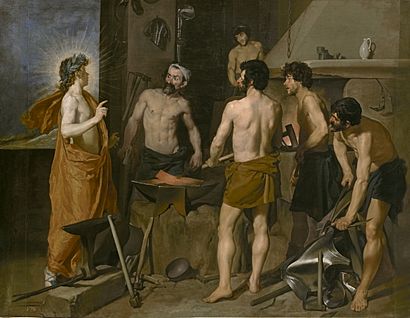Apollo in the Forge of Vulcan facts for kids
Quick facts for kids Apollo in the Forge of Vulcan |
|
|---|---|
 |
|
| Artist | Diego Velázquez |
| Year | 1630 |
| Medium | Oil on canvas |
| Movement | Baroque |
| Dimensions | 223 cm × 290 cm (87+3⁄4 in × 114+1⁄8 in) |
| Location | Museo del Prado, Madrid, Spain |
Apollo in the Forge of Vulcan (Spanish: Apolo en la Fragua de Vulcano), also known as Vulcan's Forge, is a famous oil painting. It was created by the Spanish artist Diego Velázquez in 1630. He painted it after his first trip to Italy.
Many art experts agree that this painting is one of Velázquez's most important works from that trip. It is praised for how natural and connected the figures in the painting look. The painting is now part of the collection at the Museo del Prado in Madrid, Spain. It arrived there in 1819.
What the Painting Shows
This painting tells a story from mythology. It shows the god Apollo visiting Vulcan, the god of fire and metalworking. Vulcan is busy making weapons when Apollo arrives.
Apollo, who you can spot by the laurel wreath on his head, shares some surprising news. He tells Vulcan something about Vulcan's wife, Venus, and the god Mars. The other figures in the room, who are Vulcan's helpers, look very surprised by this news. Some even have their mouths open!
Velázquez got the idea for this painting from an old engraving. He changed it a lot to focus on Apollo's arrival. He used a Baroque style, which was popular at the time. This style often shows drama and strong emotions.
Velázquez painted this artwork in Rome. He did not have a specific order from the king for it. However, it soon became part of the royal art collection. He painted it as a pair with another work called Joseph's Tunic.
Colors and Materials
Over time, some of the colors in the painting have changed. This means the painting does not look exactly as it did when Velázquez first finished it.
For example, Apollo's laurel wreath was originally green. Velázquez made this green by mixing blue azurite with yellow colors. But the yellow part of the paint was not very stable. Now, the wreath looks almost blue.
The color of the loincloths worn by some figures also changed. They used to be a different color but are now a dark brown. However, the skin tones, made with yellow ochre and other pigments, have mostly stayed the same.
See also
 In Spanish: La fragua de Vulcano para niños
In Spanish: La fragua de Vulcano para niños
- List of works by Diego Velázquez

